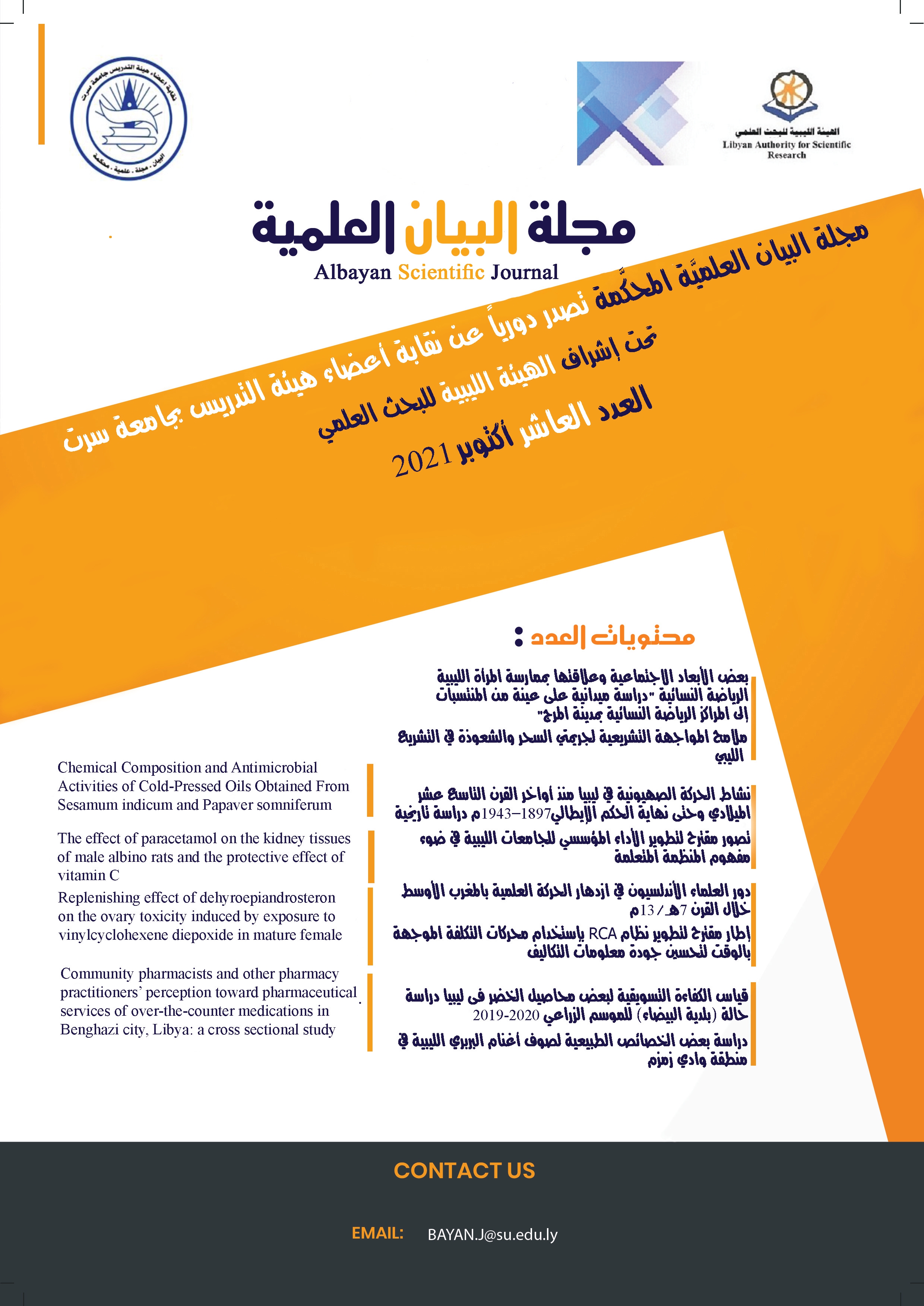Replenishing effect of dehyroepiandrosteron on the ovary toxicity induced by exposure to vinylcyclohexene diepoxide in mature female rats
الكلمات المفتاحية:
ديهيدرو إيبي أندروستيرون ،، ثنائي أكسيد الفينيل سيكلوهكسين ،، الجهاز التناسلي ،، الهرمونات الجنسية ،، إناثالملخص
تأثير تجديد مادة ديهيدرو إيبي أندروستيرون على سمية المبيض الناجمة عن التعرض لمادة ثنائي أكسيد الفينيل سيكلوهكسين
في إناث الفئران الناضجة
إن تجريع هرمون ديهيدرو إيبي أندروستيرون (DHEA) للإناث كان له تأثيرات إيجابية على استجابة المبيض، احتياطي المبيض، جودة إنتاج الأجنة من البويضات، معدل الحمل التراكمي، معدل المواليد الأحياء، وكذلك تحسين معدل الإجهاض وتحسين نتائج علاج العقم. الهدف من هذه الدراسة هو فحص تأثير تجديد مادة ديهيدرو إيبي أندروستيرون (DHEA) على السمية الناتجة عن التعرض لثنائي أكسيد الفينيل سيكلوهكسين (VCD) على إناث الفئران الناضجة. تم تقسيم 48 أنثى ناضجة إلى أربع مجموعات متساوية. تم حقن مجموعة التحكم داخل الصفاق بزيت السمسم (0.2 مل) يوميا لمدة 45 يوما. تم حقن المجموعة الثانية بـ 0.2) DHEA مل) مرة واحدة يوميًا لمدة 45 يومًا. المجموعة الثالثة تم حقنها بـ VCD (1.2مل) مرة واحدة يوميا لمدة 45 يوما. تم حقن المجموعة الرابعة بـ 0.2) DHEA مل) + 1.2) VCDمل) مرة واحدة يوميًا لمدة 45 يومًا. أظهرت النتائج أن الإناث المعالجة بـ DHEA كانت قريبة من الفئران الضابطة في معظم مستويات هرمونات البلازما المقاسة ، باستثناء هرموني DHEA و CORT. بينما سجلت المجموعة المعالجة بـ VCD انخفاضًا معنويًا (P <0.05) في معظم الهرمونات (P4 و E2 و FSH و LH و INS و DHEA) باستثناء هرمون CORT. وتجدر الإشارة إلى التحسن التدريجي الذي حدث نتيجة إعطاء DHEA للإناث المعالجة بـ VCD في مستويات جميع الهرمونات مقارنة بالفئران الضابطة. الفحص النسيجي المرضي لمبيض إناث الفئران في مجموعة VCD يظهر ضمور الجريب البدائي مع نوى متجمدة. تكشف مجموعة DHEA عن جريب بدائي طبيعي مع نوى عين البومة. مجموعة (DHEA+VCD) تكشف عن الجريب الأساسي الطبيعي مع نوى عين البومة. من الدراسة الحالية يمكن استنتاج أن إعطاء DHEA إلى أناث الجرذان يحسن الوظيفة الإنجابية ، ومن المهم وجود السلائف الستيرويدية لتخليق الستيرويد الجنسي ويتم تغييره إلى الأندروجينات أو الإستروجين. يحفز هرمون الاستروجين المبايض ويزيد من نمو الجريبات وتكاثر الخلايا الحبيبية وتطورها.
المراجع
References
Ahn, H., An, B., Jung, E., Yang, H., Choi, K. and Jeung, E. B. (2012): Parabens inhibit the early phase of folliculogenesis and steroidogenesis in the ovaries of neonatal rats. Mol. Reprod. Dev., 79: 626–636.
Al-Aridi, R., Abdelmannan, D. and Arafah, B. (2011): Biochemical diagnosis of adrenal insufficiency: the added value of dehydroepiandrosterone sulfate measurements. Endocr. Pract., 17(2): 261–270.
Auchus, R. (2004): Thebackdoor pathway to dihydrotestosterone. Trends Endocrinol Metab., 15: 432-438.
Bancroft, J. and Layton, C. (2013): The Hematoxylin and eosin. In: Suvarna S. K, Layton C, Bancroft J. D, editors. Theory Practice of histological techniques. 7th ed. Ch. 10 and 11. Philadelphia: Churchill Livingstone of El Sevier; pp. 179–220. Res. 49(6): 685-693.
Barad, D. and Gleicher, N. (2006): Effect of dehydroepinadrosterone on oocytes and embryo yields, embryo grade and cell number in IVF. Hum Reprod 21: 2845–9.
Casson, P., Lindsay, M., Pisarska, M., Carson, S. and Buster, J. (2000): Dehydroepiandrosterone supplementation augments ovarian stimulation in poor responders: A case series. Hum. Reprod., 15: 2129–32.
Chen, H., Perez, J. N., Constantopoulos, E., McKee, L., Regan, J., Hoyer, P. B., Brooks, H. L. and Konhilas, J. (2014): A method to study the impact of chemically-induced ovarian failure on exercise capacity and cardiac adaptation in mice. J. Vis. Exp., (86): e51083.
DeVet, A., Laven, J. S., de Jong, F. H., Themmen, A. P. and Fauser, B. C. (2002): Antimullerian hormone serum levels: a putative marker for ovarian aging. Fertil. Steril., 77: 357-362.
Feuerstein, P., Puard, V., Chevalier, C., Teusan, R., Cadoret, V. and Guerif, I. (2012): Genomic assessment of human cumulus cell marker genes as predictors of oocyte developmental competence: impact of various experimental factors. PLoSOne, 7: 404-49.
Frye, J. B., Lukefahr, A. L., Wright, L. E., Marion, S. L., Hoyer, P. B. and Funk, J. L. (2012): Modeling perimenopause in sprague-dawley rats by chemical manipulation of the transition to ovarian failure. Comp. Med., 62: 193–202.
Gandhi, J., Chen, A. and Dagur, G. (2016): Genitourinary syndrome of menopause an overview of clinical manifestations, pathophysiology, etiology, evaluation, and management. Am. J. Obstet. Gynecol., 215: 704-711.
Hannon, P. R. and Flaws, J. A. (2015): The effects of phthalates on the ovary. Front. Endocrinol., 6: 8.
Hashimoto, K. (2013): Sigma-1 receptor chaperone and brain-derived neurotrophic factor: Emerging links between cardiovascular disease and depression. Prog. Neurobiol., 100: 15-29.
Hatzirodos, N., Bayne, R., Irving-Rodgers, H., Hummitzsch, K., Sabatier, L., Lee, S., Bonner, W., Gibson, M., Rainey, W. and Carr, B. (2011): Linkage of regulators of TGF-beta activity in the fetal ovary to polycystic ovary syndrome. FASEBJ, 25: 2256–2265.
Kao, S., Sipes, I. and Hoyer, P. (1996): Early effects of ovotoxicity induced by 4-vinylcyclohexene diepoxide in rats and mice. Reprod. Toxicol., 13: 67-75.
Labrie, F., Martel, C. and Bélanger, A. (2017): Androgens in women are essentially made from DHEA in each peripheral tissue according to intracrinology, 168: 9-18.
Labrie, F. (2010): DHEA, important source of sex steroids in men and even more in women. Prog. Brain Res., 182: 97-148.
Liu, T. C., Lin, C. H., Huang, C. Y., Ivy, J. L. and Kuo, C. H. (2013): Effect of acute DHEA administration on free testosterone in middle-aged and young men following high-intensity interval training. European journal of applied physiology, 113: 1783–1792.
Maayan, R., Morad, O., Dorfman, P., Overstreet, D., Weizman, A. and Yadid, G. (2005): Theinvolvemet of dehydroepiandrosterone (DHEA) in blocking the therapeutic effect of electroconvulsive shocks in an animal model of depression. EurNeuropsychopharmacol, 15(3): 253-62.
Okeke, T., Anyaehie, U. and Ezenyeaku, C. (2013): Premature menopause. Ann. Med. Health Sci. Res., 3: 90–95.
Panjari, M. and Davis, S. (2007): DHEA therapy for women: effect on sexual function and wellbeing. Human Reproduction Update, 13: 239–248.
Shahed, A. and Young, K. A. (2013): Anti-mullerian hormone (AMH), inhibin-alpha, growth differentiation factor 9 (GDF9), and bone morphogenic protein-15 (BMP15) mrna and protein are influenced by photoperiod-induced ovarian regression and recrudescence in siberian hamster ovaries. Mol. Reprod. Dev., 80: 895–907.
Sunkara, S., Coomarasamy, A., Arlt, W. and Bhattacharya, S. (2012): Should androgen supplementation be used for poor ovarian response in IVF? Hum. Reprod., 27: 637–40.
Tan, O., Bradshaw, K. and Carr, B. (2012): Management of vulvovaginal atrophy-related sexual dysfunction in postmenopausal women: an up-to-date review. Menopause, 19: 109-117.
Tello, R. and Crewson, P. E. Hypothesis testing II: means. Radiol., (2003); 227(1): 1-4.
Thomas, P., Converse, A. and Berg, H. (2018): A novel membrane androgen receptor and zinc transporter protein. Gen. Comp. Endocrinol., 257: 130-136.
Tsui, K., Lin, L., Chang, R., Huang, B., Cheng, J. and Wang, P. (2014): Effect of dehydroepiandrosterone supplementation on women with poor ovarian response. 77: 505-507.
Vo, T., An, B., Yang, H., Jung, E., Hwang, I. and Jeung, E. (2012): Calbindin-D9K as a sensitive molecular biomarker for evaluating the synergistic impact of estrogenic chemicals on GH3 rat pituitary cells. Int. J. Mol. Med., 30: 1233–1240.
Wiser, A., Gonen, O., Ghetler, Y., Shavit, T., Berkovitz, A. and Shulman, A. (2010): Addition of dehydroepiandrosterone (DHEA) for poor-responder patients before and during IVF treatment improves the pregnancy rate: A randomized prospective study. Hum. Reprod., 25: 2496–2500.













